London’s New Bond Street has retained its crown as the UK’s most expensive street by store rental value, with its rent significantly higher than all other UK retail locations, even in London, according to data from Cushman & Wakefield.
The annual ‘Main Streets Across the World’ report, now in its 30th year, tracks 446 of the top retail streets around the globe, ranking them by their prime rental value according to Cushman & Wakefield’s proprietary data, which includes a list of the top streets in 65 countries.
New Bond Street’s annual rent of US$1,744psf/yr puts it first in the UK and Europe and third globally behind Upper 5th Avenue, New York (US$2,250 psf/yr) in second. For the first time in five years Hong Kong’s Causeway Bay takes top spot globally, with average rents costing US$2,671 psf/yr.
From a purely UK and Ireland perspective, seven of the top 10 locations are in London with only Dublin’s Grafton Street and Henry Street, along with Glasgow’s Buchanan Street breaking up the monopoly.
Of the UK locations in the survey, Edinburgh’s Princes Street has seen the largest rental increase, rising by 11.6% over the year to June 2017 to US$218 psf/yr, closely followed by Shop Street in Galway, which has increased by 9.1% to US$132 psf/yr.
Rents in Newcastle’s prime retail pitch, Northumberland Street were stable at US$162 psf/yr, the same as 2017.
Peter Atkinson, Partner in Cushman & Wakefield’s Investment team in Newcastle said: “In a rapidly changing retail environment with many high street rents going backwards, it’s pleasing to see Newcastle’s, Northumberland Street, remaining stable. New entrants to the city such Smiggle, Thomas Sabo, Kiko Milano, Tiger, Vans and Monki have helped maintain consumer interest, as has the city’s many new leisure and experience destinations such as Stack and Greys Quarter.
“However, looking around the country at other leading regional centres and shopping destinations, it is apparent that Newcastle cannot rest on its laurels merely as a dominant regional capital. The growth of online retail and, to a certain extent, improved accessibility to other leading cities means that retail is no longer competing at a local or even regional level. The drive towards multi-channel retailing means that retail and leisure environments that embrace technology and deliver a varied and unique experience will survive and prosper.
“Newcastle City Council and NE1 initiatives such as public realm improvements, Restaurant Week, Screen on the Green, Quayside Seaside have been a great success, but more is needed. Exciting plans to transform Northumberland Street, pedestrianise Blackett Street and digitise the city are in the making so watch this space.”
Report author Darren Yates, Head of EMEA Retail Research at Cushman & Wakefield, said: “There is still a significant appetite for premium retail sites globally, with the top retailers using stores as part of their customer experience strategy.
“While global trends are not completely uniform, there are some common themes. The most notable include the continued growth of online, omni-channel retailing as standard and significant investment in store design. While technology is still a major disruptor in retailing, it is also enabling physical retail to fight back as it allows retailers to better understand their customers and to enhance the in-store experience.
“New Bond Street’s dominance underlines London’s attraction as an important location for retailers particularly at the premium end of the market. Overall, thoroughfares across the Capital have generally maintained their rental values. However, around the UK, the polarisation between prime and secondary locations is increasingly evident, which is reflected in the wide disparity of rental levels and vacancy rates.”





















